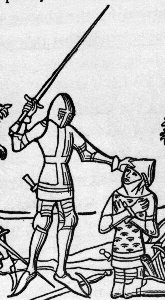
| The first knights were just soldiers on horseback, but from the 1100s on, they were expected to follow a strict code of honor. They became part of the noble and superior class of people, just like their lord and lady. Medieval men did not become knights overnight, but spent many years of tenuous training from an early age. |
A boy begins as a page at the age of seven. He runs errands, waits tables, and learns etiquette, or manners. He accompanies his mentor-knight to the field as an assistant. He learns skills of horsemanship and begins mastering light weapons, such as the bow and arrow, dagger, and sword. He also learns about sports such as hawking and hunting.
Around age fourteen, the boy is promoted to being a squire. He acts as a personal servant to his knight, taking care of that knight�s shield and armor and helping him to dress in the elaborate armor suit. A squire practices using heavier weapons, such as the battle-axe, crossbow, and lance. He enjoys athletics, like rock-climbing and jousting, in addition to hunting and hawking. He learns to tolerate hunger, thirst, heat, cold, and sleeplessness.
 |
Once the squire has reached the appropriate level of maturity, around age twenty-one, he undergoes the ritual of knighting, which is called dubbing. A French poem called the Order of Knighthood explains each of the parts of the knighting ceremony. A captor, named Saladin, wishes to be knighted in exchange for freedom of the hostage, named Hugh, without ransom.
The night before the dubbing, Saladin is bathed in a tub of hot water, which is symbolic of a child being baptized with water. Then Saladin goes to sleep in a nice bed, which stands for the comfort he will enjoy in Heaven, if he earns this reward by being faithful. The next morning, he is dressed in a white robe (to show cleanliness). The ceremony takes place in the church. The priest holds a sword and touches it on the new knight�s head. The priest lists reviews the code of chivalry, and afterwards all of the people celebrate. |
Knights followed a strict code of ethics and virtues. The code of chivalry was the ideal model of knighthood, which was important for knights to follow. Knightly virtues included: liberality, honor, good faith, glory, unselfishness, pride, patience, courtesy, bravery, and loyalty. | 
|
Definitions of these virtues:*
Liberality- generous and tolerant
Honor- respects others and acts with integrity
Good faith- trust in God and loyalty to peers
Glory- praise and magnificence
Unselfishness- generous and thoughtful of others
Pride- self-respectful
Patience- bearing pain without complaint and showing self-control
Courtesy- politeness, (especially to the ladies)
Bravery- courage
Loyalty- faithful and trusting of king and fellow knights


Jousting was an athletic competition, similar to how football is today, except that knights are on horseback with lances, or long pointed sticks. A knight would try to knock the other to the ground. These tournaments offered the young knights a chance to make a name for themselves, which could sometimes lead to a beneficial marriage. Prizes of armor or gold were awarded to the winners. Although knights often jousted with less sharp wooden weapons, injuries and deaths were common.
